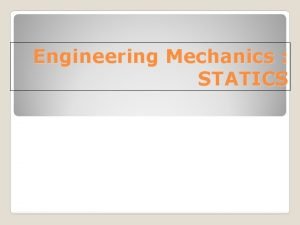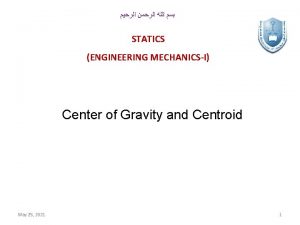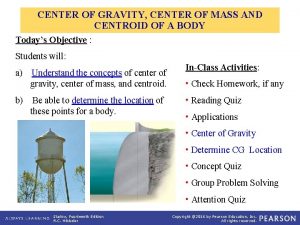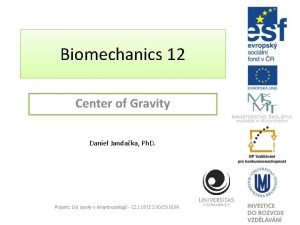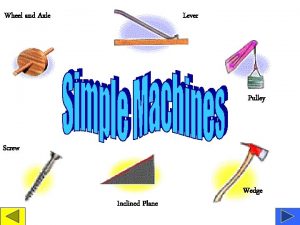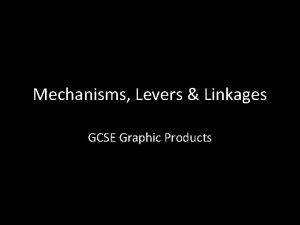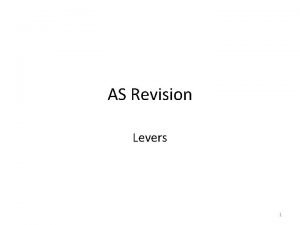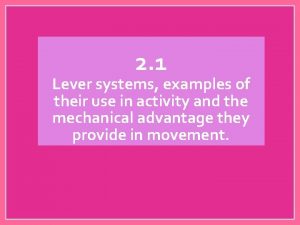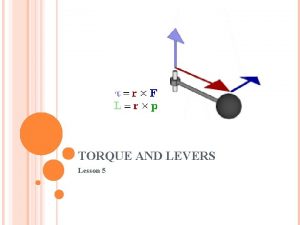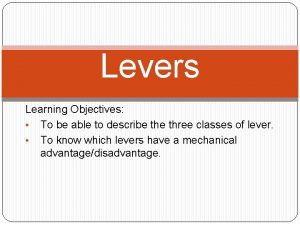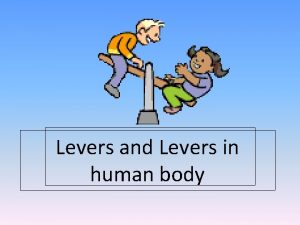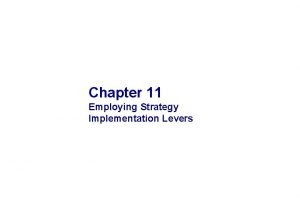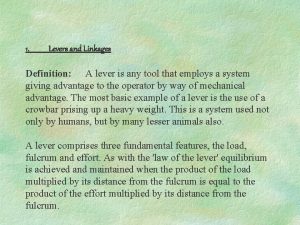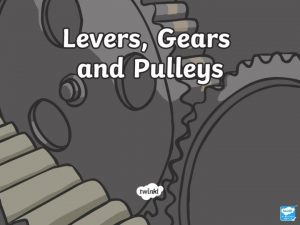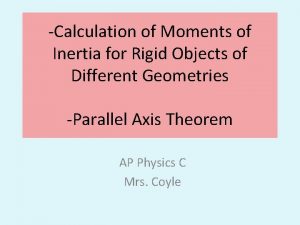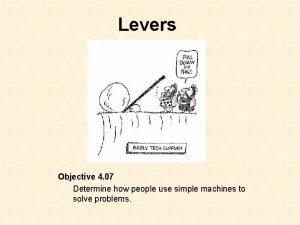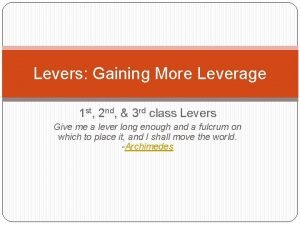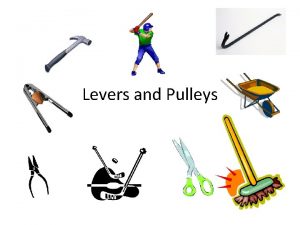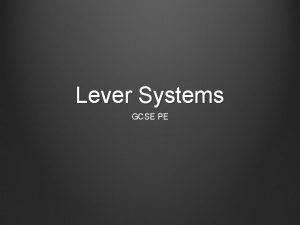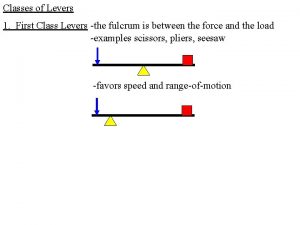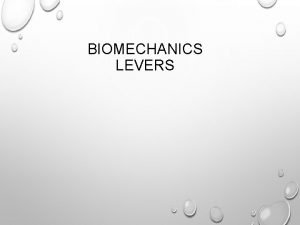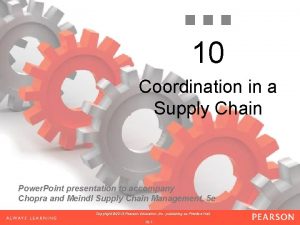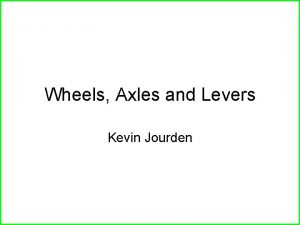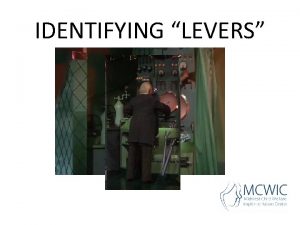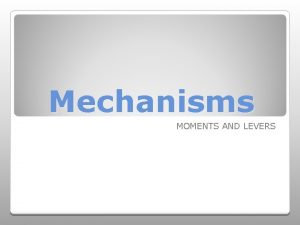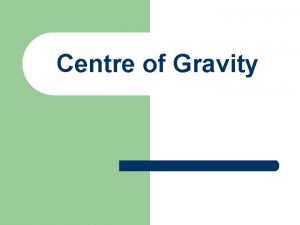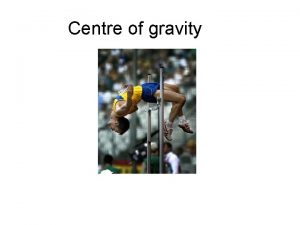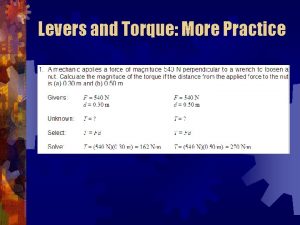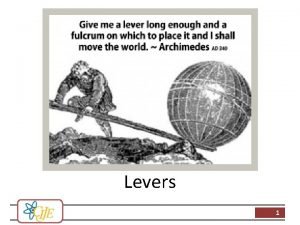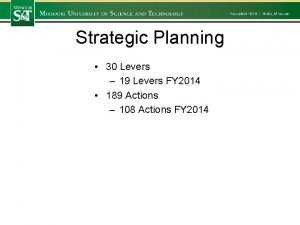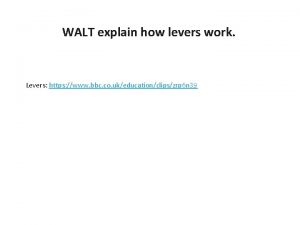Levers Moments and Centre of Gravity Moments and






























- Slides: 30

Levers , Moments and Centre of Gravity

Moments and Centre of Gravity Things you need to know in this section Turning effect of a force. Calculating turning effect (moment). Levers definition (4 examples) Law of the lever and experiment to prove it. Centre of gravity and how to find it. Equilibrium (3 types) + examples Connection between stability and equilibrium. Examples. Remember lever demonstration


Levers • A lever is rigid body free to move about a fixed point called the fulcrum.

Moments(turning forces) make things turn or rotate. They are caused by forces but are not forces themselves. The moment will be bigger if: The force causing the turning effect is bigger. The force is further from the fulcrum. How can the turning effect of a force be increased?

Calculating the size of a moment (turning force) Moment = Force x Distance Nm Newtons N m Which is easier to loosen a nut, a spanner with a long handle or a spanner with a short handle and why? Why is it easier to shift a large boulder with a crow-bar that without the crow-bar?

BALANCED Net moment is zero = net turning force is zero Anti-clockwise Moment = Clockwise Moment

Balanced Forces

Write out the statements that are true. • a The longer the lever, the bigger the force that is needed to move an object. • b It is easier to close a door if you push the door close to the hinge • c The shorter the lever, the bigger the force that is needed to move an object • d Joints are examples of pivots. • e Bones are examples of levers.

Answers are C, D and E

How could we prove the law of the lever? What apparatus do we need? What measurements must be taken?


Recording your results • What do we need to record? • How many columns will we need in our table?

Recording your results

Write out each term along with its correct description t unbalanced ba n l e a nced m o s yste system m m Descriptions • anticlockwise moments = clockwise moments • two boys of different weights sit opposite each other on a see saw, both the same distance from the pivot • the turning effect of a force

Moment calculation Gina weighs 500 N and stands on one end of a seesaw. She is 0. 5 m from the fulcrum. What moment does she exert? moment = 500 x 0. 5 = 250 Nm 0. 5 m 500 N Fulcrum

Moment equation The moment of a force is given by the equation: moment = force (N) x distance from fulcrum (cm or m) moment f x d Moments are measured in Newton centimetres (Ncm) or Newton metres (Nm).

Law of the lever The girl on the left exerts an anti-clockwise moment, which equals. . . The girl on the right exerts a clockwise moment, which equals. . . her weight x her distance from fulcrum Can you see any practical application of a balanced lever?

Law of the Lever If the sum of the anticlockwise moments and sum of the clockwise moment are equal then the lever is balanced. This is known as the Law of the lever. When something is balanced about a fulcrum: total clockwise moment = total anticlockwise moment

Law of the lever – calculations Two girls are sitting on opposite sides of on a see-saw. One girl weighs 200 N and is 1. 5 m from the fulcrum. Where must her 150 N friend sit if the seesaw is to balance? When the see-saw is balanced: total clockwise moment = total anticlockwise moment 200 N x 1. 5 m = 150 N x distance 200 x 1. 5 = distance 150 distance of second girl = 2 m

Why don’t cranes fall over? Tower cranes are essential at any major construction site. load arm trolley counterweight loading platform tower Concrete counterweights are fitted to the crane’s short arm. Why are these needed for lifting heavy loads?

Why don’t cranes fall over? Using the law of the lever, when is the crane balanced? 3 m 6 m ? 10, 000 N moment of = moment of load counterweight If a 10, 000 N counterweight is three metres from the tower, what weight can be lifted when the loading platform is six metres from the tower?

Why don’t cranes fall over? moment of load = load x distance of load from tower = ? x 6 moment of = counterweight x distance of counterweight from tower = 10, 000 x 3 = 30, 000 Nm moment of load = moment of counterweight ? x 6 = 30, 000 ? = 3, 000 6 ? = 5, 000 N

Crane operator activity Where should the loading platform be on the loading arm to carry each load safely?

Centre of Gravity How does centre of gravity affect stabilty? Why is it difficult to carry a long pole holding at one end instead of holding in the centre. (remember long wooden pole ask students to hold in the middle and the at the end) The centre of gravity of a object is the point through which the weight of an object appears to act

Centre of Gravity

Centre of Gravity • In what way are racings cars designed to make them more stable? • Why are not allowed to stand on the upper deck of a double decker bus? • Which is a better design a mug with a narrow base or a mug with a wide base? Why?

Equilibrium

Measuring Centre of Gravity Move the card in the diagram until it just about to fall off. Draw the líne along the card parallel to the edge of the bench. Do this for two other direction of the card. Where the lines meet is the centre of gravity.

Factors affecting stability Low centre of gravity This means the object can tilt over a long way and centre of gravity is still inside the base so it so not topple over. Wide base This means a better chance of the centre of gravity staying over the base, less chance of topplng over.
 Centroid in mechanics
Centroid in mechanics Centre of gravity of different shapes
Centre of gravity of different shapes Gravity for dummies and dummies for gravity equations
Gravity for dummies and dummies for gravity equations Centroid mechanics
Centroid mechanics Gravity
Gravity Centre of gravity formula
Centre of gravity formula Jandaka
Jandaka Centre of gravity in gymnastics
Centre of gravity in gymnastics Biomechanical principles pdhpe
Biomechanical principles pdhpe Screw driver wheel and axle
Screw driver wheel and axle Types of linkages mechanisms
Types of linkages mechanisms The ankle is a third class lever.
The ankle is a third class lever. Second class lever examples in sport
Second class lever examples in sport Torque and levers
Torque and levers Disadvantages of second class levers
Disadvantages of second class levers Fixed pulley examples in human body
Fixed pulley examples in human body Lever for strategy implementation
Lever for strategy implementation Defination of lever
Defination of lever Gears pulleys and levers
Gears pulleys and levers Icm + md^2
Icm + md^2 There are three types of
There are three types of Sae control pattern
Sae control pattern Fle 123 levers
Fle 123 levers Example of lever
Example of lever Orders of levers
Orders of levers Fle 123 levers
Fle 123 levers Levers gcse
Levers gcse First class levers
First class levers Biomechanics levers
Biomechanics levers Managerial levers to achieve coordination
Managerial levers to achieve coordination In anatomic lever systems, the fulcrum is the
In anatomic lever systems, the fulcrum is the



